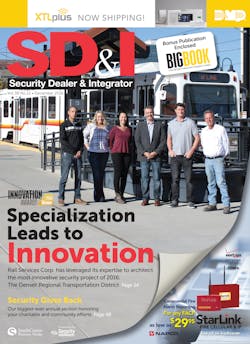Specialization Leads to Innovation
For many security integrators, specialization is one of the primary keys to success – if they become the go-to source for a particular market or widespread customer, it should translate into business success for years to come. For others, specialization is a byproduct of a business that was entrenched in a particular market and then later expanded into security.
Such is the case for New Orleans-based Rail Services Corp. (RSC), which launched in the 1980s as a provider of train control products but soon expanded into security integration services. “We added typical security systems, such as video surveillance and intrusion detection, as our customers demanded it,” says Mike Tiffin, RSC’s VP Of Operations. “We are true systems integrators in that we don’t carry just one product, but we offer engineering and services that will meet the unique customer’s needs. All of our systems fall under the umbrella of 'communications' within the transit business.”
“I used to think of myself as a software person, but after 34 years building transit systems, I have to admit that I might be a transit communications person,” says RSC President and founder Kevin Hassett, who is well known in the train control side of the business.
Today, RSC is almost solely focused on communication systems for the transit industry – which includes rail and bus. These systems interface with other unique systems elements of transit, including signal, traction power and security. This specialization proved to be an extremely valuable asset for RSC in its success as integrator and consultant for a major project with the Denver Regional Transportation District (RTD) – which was named by Southcomm Security Media as the Grand Platinum Innovation Award, signifying the most innovative security project of 2016.
Inside the Winning Project
Heightened security threats, extreme weather conditions and tough macro-economy conditions all contributed to the complexities and challenges of the Denver RTD project. Serving more than 2.87 million people, Denver RTD operates public transit services in eight of the 12 counties in the Denver-Aurora-Boulder area of Colorado. It is responsible for hundreds of buses and bus stops, dozens of light-rail stations, park-and-ride facilities and train depots.
Taking a phased approach to security that always kept passenger safety and satisfaction at the heart of their planning, Denver RTD has been methodically and continually improving their transit system for more than a decade. RSC serves in the dual role of systems integrator and consultant for the ongoing project. “Security is not as well understood in the transit business as it is in other markets, but there is tremendous pressure from Homeland Security to provide something,” Tiffin says. “Some of the requirements are leading-edge encryption and network security; some are traditional video surveillance systems with some new sizzle.”
RSC and RTD have taken a “team” approach when it comes to their working relationship. “It takes many people to deliver a successful solution,” Tiffin says. “Each person or company on the team have – at one point or another – served on RTD’s projects as consultants, integrators, project managers, technicians, and decision makers. We haven’t had the need to define each layer and that is very refreshing and productive.”
The project was segmented into three phases: the first was securing crime-prone areas and reducing crime rates; the second involved securing bus transportation and improving investigations; and the third and final phase focused on smartly integrating information from all systems and sensors to provide a common operating picture and enable effective situation management.
Phase One: In 2002, Denver RTD had to monitor more than 1,000 fixed cameras via a video surveillance system that was distributed and non-networked. Like many end-users, the transit system was introduced to networked cameras and technology – and officials quickly realized the utility and value of having a unified, networked system that could be monitored, controlled and managed from a centralized location. This first phase of the project leveraged a new IP network, along with a video management system from NICE Systems (which transitioned to the Qognify brand in Sept. 2015).
Phase Two: Working closely with vendors including Qognify and Panasonic, RSC and the end-user attacked phase two of the project – retrofitting all buses with updated and advanced networked video systems. “We had to pull hard drives off of buses for 20-40 cases per day,” Bob Grado, Transit Police Commander and Manager of Integrated Security Operations for Denver RTD, explains of the original analog systems aboard the buses.
Given that Denver RTD conducts more than 9,000 investigations every year, video camera failures and inaccessible recordings were a significant problem. RSC worked with the transit authority to redesign camera layouts within the buses – with nine interior cameras delivering high-definition images in each –as well as an innovative recording and retrieval system. The solution has been deployed in more than 450 buses, with more than 600 more to be installed in the next three years.
The solution uses Qognify’s enterprise VMS software, running on hardware from Panasonic, and includes specialty cameras and a mobile recording platform designed to withstand the vibration and extreme weather experienced by the buses. “Hardened NVRs are required for vehicles,” Tiffin explains. “Effective planning and design are taken into consideration so storage solutions are customized for each application to maximize retention.”
The system’s biggest benefit is its ability for investigators to access recordings remotely through an advanced investigation solution. Instead of going to the depot to manually remove hard drives from the buses, investigators can just type in the bus number, date, and time range into the investigation solution. When the bus pulls into the depot and connects with Wi-Fi, the system automatically receives the request and begins to download the video. Additionally, mobile video recordings can be combined with radio recordings and fixed surveillance video to create a complete incident timeline.
Phase three: By 2015, the video management system had grown to more than 12,000 fixed and mobile video cameras from Panasonic and Axis Communications that are spread across Denver RTD stations, facilities and assets. A massive and growing amount of information was being funneled into Denver RTD’s Security Command Center from the various systems and sensors that RSC deployed – including access control, video surveillance, smoke detectors and more.
The vast amount of information, coupled with the need to share information in real time with field personnel, created the demand a PSIM/Situation Management platform. Qognify’s Situator has provided the situation management capabilities that include understanding what is happening, visualization of where it is happening, and knowing what to do to effectively and proactively respond to the unfolding event.
“Proactive alarm and security management is always a challenge, but Denver RTD’s network and openness to new ideas have allowed for a collaborative work environment to get information to the appropriate personnel,” Tiffin says. “RTD has implemented an extensive network which made our job of getting the data less complex. PSIM requires a lot of foresight and cooperation from both sides, but in this project, we were able to make it work.”
The PSIM’s unified management of all systems and sensors were integrated by RSC into all of Denver RTD’s command centers. They are integrated into a common operating picture, along with automated response plans and GIS integration of sensors, doors, video cameras and other data so it is overlaid on Denver RTD maps. This enables personnel to have immediate clarity on the nature and location of a security incident, giving operators the tools and support via automated, pre-defined workflows to proactively coordinate a real-time response to incidents that include federal, state, local agencies and armed on-board officers.
The Future
In addition to the continued retrofitting of bus surveillance systems and other Denver RTD facilities, RSC provides all the necessary equipment and labor required to keep the safety and security systems up and running at all times as part of an ongoing service and maintenance agreement.
In addition, RSC and RTD are continually testing new technologies to determine what to add to the system. Their vision includes connecting the command center of a new commuter rail – a train line from downtown Denver to Denver International Airport – to the existing Light Rail and Bus Security Command Center for true enterprise-wide control of security and operations from either command center.
“We are always upgrading and expanding the RTD systems,” Tiffin says. “RTD is known for its innovative culture – when a new product or service hits the market, we research how it might help protect assets or create efficiencies in operations. If it is determined that a benefit can be achieved, we will continue with pilot programs and eventually implement the solution into the production environment.”
In April 2016, Denver RTD’s security program and systems were commended by the Transportation Security Administration – receiving TSA’s highest rating of “Gold Standard.”
Creating a Gold Standard, Innovation Award-winning security system for a transit agency is a complex undertaking that takes years of experience. That said, for a systems integrator like RSC, the key elements of success are not unlike most security projects – from a four-camera retail system to one with thousands of cameras spread over hundreds of square miles. “Listen to your customer,” Tiffin says, and offer the solution for the transit system that you would want protecting yourself and your family.”
Paul Rothman is Editor in Chief of Security Dealer & Integrator (SD&I) magazine. Access the current issue along with archives and to subscribe, visit www.secdealer.com.







